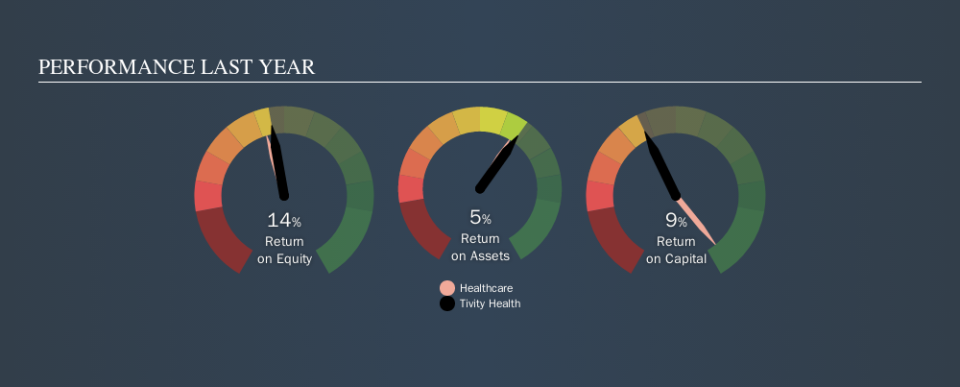How Good Is Tivity Health, Inc. (NASDAQ:TVTY) At Creating Shareholder Value?

Today we'll evaluate Tivity Health, Inc. (NASDAQ:TVTY) to determine whether it could have potential as an investment idea. To be precise, we'll consider its Return On Capital Employed (ROCE), as that will inform our view of the quality of the business.
First of all, we'll work out how to calculate ROCE. Second, we'll look at its ROCE compared to similar companies. Then we'll determine how its current liabilities are affecting its ROCE.
Understanding Return On Capital Employed (ROCE)
ROCE is a measure of a company's yearly pre-tax profit (its return), relative to the capital employed in the business. In general, businesses with a higher ROCE are usually better quality. Ultimately, it is a useful but imperfect metric. Author Edwin Whiting says to be careful when comparing the ROCE of different businesses, since 'No two businesses are exactly alike.
How Do You Calculate Return On Capital Employed?
Analysts use this formula to calculate return on capital employed:
Return on Capital Employed = Earnings Before Interest and Tax (EBIT) ÷ (Total Assets - Current Liabilities)
Or for Tivity Health:
0.089 = US$165m ÷ (US$2.0b - US$159m) (Based on the trailing twelve months to June 2019.)
Therefore, Tivity Health has an ROCE of 8.9%.
View our latest analysis for Tivity Health
Is Tivity Health's ROCE Good?
ROCE is commonly used for comparing the performance of similar businesses. We can see Tivity Health's ROCE is around the 11% average reported by the Healthcare industry. Aside from the industry comparison, Tivity Health's ROCE is mediocre in absolute terms, considering the risk of investing in stocks versus the safety of a bank account. Investors may wish to consider higher-performing investments.
Tivity Health's current ROCE of 8.9% is lower than its ROCE in the past, which was 29%, 3 years ago. So investors might consider if it has had issues recently. You can click on the image below to see (in greater detail) how Tivity Health's past growth compares to other companies.
It is important to remember that ROCE shows past performance, and is not necessarily predictive. ROCE can be misleading for companies in cyclical industries, with returns looking impressive during the boom times, but very weak during the busts. This is because ROCE only looks at one year, instead of considering returns across a whole cycle. Future performance is what matters, and you can see analyst predictions in our free report on analyst forecasts for the company.
What Are Current Liabilities, And How Do They Affect Tivity Health's ROCE?
Liabilities, such as supplier bills and bank overdrafts, are referred to as current liabilities if they need to be paid within 12 months. Due to the way ROCE is calculated, a high level of current liabilities makes a company look as though it has less capital employed, and thus can (sometimes unfairly) boost the ROCE. To counteract this, we check if a company has high current liabilities, relative to its total assets.
Tivity Health has total liabilities of US$159m and total assets of US$2.0b. As a result, its current liabilities are equal to approximately 7.9% of its total assets. With low levels of current liabilities, at least Tivity Health's mediocre ROCE is not unduly boosted.
What We Can Learn From Tivity Health's ROCE
If performance improves, then Tivity Health may be an OK investment, especially at the right valuation. But note: make sure you look for a great company, not just the first idea you come across. So take a peek at this free list of interesting companies with strong recent earnings growth (and a P/E ratio below 20).
I will like Tivity Health better if I see some big insider buys. While we wait, check out this free list of growing companies with considerable, recent, insider buying.
We aim to bring you long-term focused research analysis driven by fundamental data. Note that our analysis may not factor in the latest price-sensitive company announcements or qualitative material.
If you spot an error that warrants correction, please contact the editor at editorial-team@simplywallst.com. This article by Simply Wall St is general in nature. It does not constitute a recommendation to buy or sell any stock, and does not take account of your objectives, or your financial situation. Simply Wall St has no position in the stocks mentioned. Thank you for reading.

 Yahoo Finance
Yahoo Finance 
